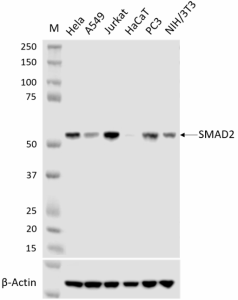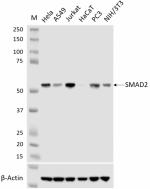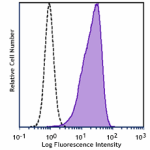- Clone
- W21150C (See other available formats)
- Regulatory Status
- RUO
- Other Names
- MAD homolog 2, JV18-1, MAD-2, MADH2, MADR2, Mad-related protein 2, Mothers against DPP homolog 2
- Isotype
- Rat IgG2b, κ
- Ave. Rating
- Submit a Review
- Product Citations
- publications

-

Whole cell extracts (15 µg total protein per lane) from the indicated cell lines were resolved on a 4-12% Bis-Tris gel, transferred to a PVDF membrane, and probed with 1 µg/mL of purified anti-SMAD2 (clone W21150C) overnight at 4°C. Proteins were visualized by chemiluminescence detection using HRP Goat anti-rat IgG (Cat. No. 405405) at a 1:5000 dilution. Direct-Blot™ HRP anti-β-actin (Cat. No. 664804) was used as a loading control at a 1:25000 dilution. Western-Ready™ ECL Substrate Premium Kit (Cat. No. 426319) was used as a detection reagent. Lane M: Molecular weight marker -

HeLa cells were fixed with fixation buffer (Cat. No. 420801), and permeabilized with True-Phos™ Perm Buffer (Cat. No. 425401). Cells were then intracellularly stained with purified anti-SMAD2 (clone W21150C) (filled histogram) or rat IgG2b, κ isotype control (Cat. No. 400602) (open histogram, dashed line), followed by incubation with 0.1 µg/test of APC Goat anti-rat IgG (Cat. No. 405407) for 15 minutes at room temperature.
| Cat # | Size | Price | Quantity Check Availability | Save | ||
|---|---|---|---|---|---|---|
| 624851 | 25 µg | $165 | ||||
| 624852 | 100 µg | $415 | ||||
SMAD2 is a potent regulator of different cellular processes such as apoptosis, differentiation, and cell proliferation. SMAD2 is associated with SARA protein and the TGF-β receptor. SMAD2 gets phosphorylated by the TGF-β receptor in response to TGF-β signaling, which induces its dissociation from SARA and association with SMAD4 followed by translocation into the nucleus. In the nucleus, the SMAD2/SMAD4 protein complex participates in gene regulation by forming a transcription repressor complex in association with other cofactors.
Product DetailsProduct Details
- Verified Reactivity
- Human, Mouse
- Antibody Type
- Monoclonal
- Host Species
- Rat
- Immunogen
- Recombinant human SMAD2 protein
- Formulation
- Phosphate-buffered solution, pH 7.2, containing 0.09% sodium azide
- Preparation
- The antibody was purified by affinity chromatography.
- Concentration
- 0.5 mg/mL
- Storage & Handling
- The antibody solution should be stored undiluted between 2°C and 8°C.
- Application
-
WB - Quality tested
ICFC - Verified - Recommended Usage
-
Each lot of this antibody is quality control tested by western blotting. For western blotting, the suggested use of this reagent is 0.125 - 1.0 µg/mL. For flow cytometric staining, the suggested use of this reagent is ≤ 0.016 µg per million cells in 100 µL volume. It is recommended that the reagent be titrated for optimal performance for each application.
- Application Notes
-
This clone cross-reacts with mouse.
For intracellular flow cytometric staining with this clone, we recommended using Fixation Buffer (Cat. No. 420801), True-Phos™ Perm Buffer (Cat. No. 425401), Intracellular Staining Permeabilization Wash Buffer (Cat. No. 421002) or Cyto-Fast™ Fix/Perm Buffer Set (Cat. No. 426803). True-Nuclear™ Transcription Factor Buffer Set (Cat. No. 424401) is not applicable.
We do not recommend this product for use in immunocytochemistry (ICC). - RRID
-
AB_3097247 (BioLegend Cat. No. 624851)
AB_3097247 (BioLegend Cat. No. 624852)
Antigen Details
- Structure
- SMAD2 is a 467 amino acid protein with a predicted molecular weight of 52 kD
- Distribution
-
Skeletal muscle, endothelial cells, heart and placenta; non-phosphorylated SMAD2 is present in the cellular cytoplasm close to the TGF-β receptor; phosphorylated SMAD2 is present in the cellular nucleus and binds to target promoter sequences.
- Function
- Apoptosis/Tumor Suppressors/Cell Death, Cell Cycle/DNA Replication, Signal Transduction, Transcription Factors
- Interaction
- TAZ/WWRT1, FOXH1, SNW1, CREB-binding protein (CBP), EP300, SNON, ALK4/ACVR1B, SKOR1, SKOR2, PRDM16, LEMD3, RBPMS, WWP1, PDPK1, DAB2, USP15, PPP5C, LDLRAD4, PMEPA1, ZFHX3, ZNF451, SMURF2, PPM1A, TGF-β, TGFBR1, TGIF, SMAD3, TRIM33, ZNF580, NEDD4, HGS, AIP1, WWP1, PML, ZNF8, RNF111, YAP1
- Ligand/Receptor
- SMAD2 is part of the TGF-β signaling pathway but it is not a ligand/receptor protein
- Biology Area
- Apoptosis/Tumor Suppressors/Cell Death, Cell Cycle/DNA Replication, Signal Transduction, Transcription Factors
- Molecular Family
- Phospho-Proteins
- Antigen References
-
- Nakao A, et al. 1997. EMBO J. 16:5353–62.
- Attisano L. and Wrana JL, et al. 2002. Science. 296:1646-47.
- Moustakas A. et al. 2001. J Cell Sci. 114: 4359-69.
- Gene ID
- 4087 View all products for this Gene ID
- UniProt
- View information about SMAD2 on UniProt.org
Other Formats
View All SMAD2 Reagents Request Custom Conjugation| Description | Clone | Applications |
|---|---|---|
| Purified anti-SMAD2 | W21150C | WB,ICFC |
Compare Data Across All Formats
This data display is provided for general comparisons between formats.
Your actual data may vary due to variations in samples, target cells, instruments and their settings, staining conditions, and other factors.
If you need assistance with selecting the best format contact our expert technical support team.

 Login/Register
Login/Register 









Follow Us